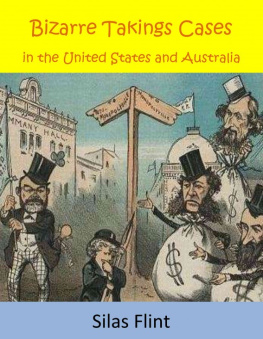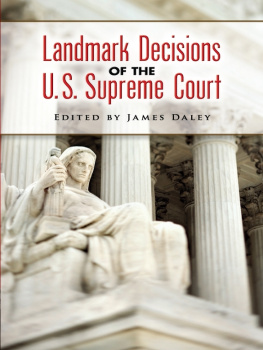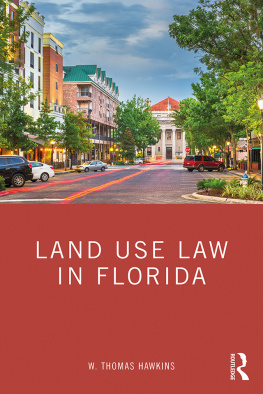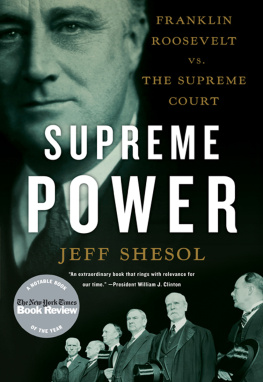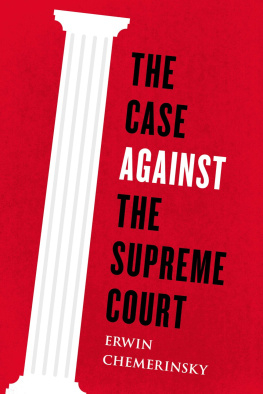Silas Flint - Bizarre Takings Cases in the United States and Australia
Here you can read online Silas Flint - Bizarre Takings Cases in the United States and Australia full text of the book (entire story) in english for free. Download pdf and epub, get meaning, cover and reviews about this ebook. year: 2014, publisher: Silas Flint, genre: Art. Description of the work, (preface) as well as reviews are available. Best literature library LitArk.com created for fans of good reading and offers a wide selection of genres:
Romance novel
Science fiction
Adventure
Detective
Science
History
Home and family
Prose
Art
Politics
Computer
Non-fiction
Religion
Business
Children
Humor
Choose a favorite category and find really read worthwhile books. Enjoy immersion in the world of imagination, feel the emotions of the characters or learn something new for yourself, make an fascinating discovery.
- Book:Bizarre Takings Cases in the United States and Australia
- Author:
- Publisher:Silas Flint
- Genre:
- Year:2014
- Rating:4 / 5
- Favourites:Add to favourites
- Your mark:
- 80
- 1
- 2
- 3
- 4
- 5
Bizarre Takings Cases in the United States and Australia: summary, description and annotation
We offer to read an annotation, description, summary or preface (depends on what the author of the book "Bizarre Takings Cases in the United States and Australia" wrote himself). If you haven't found the necessary information about the book — write in the comments, we will try to find it.
Silas Flint: author's other books
Who wrote Bizarre Takings Cases in the United States and Australia? Find out the surname, the name of the author of the book and a list of all author's works by series.
Bizarre Takings Cases in the United States and Australia — read online for free the complete book (whole text) full work
Below is the text of the book, divided by pages. System saving the place of the last page read, allows you to conveniently read the book "Bizarre Takings Cases in the United States and Australia" online for free, without having to search again every time where you left off. Put a bookmark, and you can go to the page where you finished reading at any time.
Font size:
Interval:
Bookmark:
Bizarre Takings Cases in the United States andAustralia
by Silas Flint
Published by Silas Flint at Smashwords
Copyright 2014 Silas Flint
This book may not be reproduced, copied ordistributed without the express permission of the author. Eachperson desiring this book should obtain his own copy. Thank you forrespecting the work of this author.
Cover art courtesy the Library of Congress, "Puck'sPerplexing Position - Between Two Evils," 1881, Keppler &Schwarzmann
TABLE OF CONTENTS
A government "taking"occurs when the government takes property from a landownerregardless of whether the landowner wants to let the government tohave it. The justification is that the government should not bedenied the right to obtain property it "needs" to better serve thepublic (to install a new parking lot, for example) just because alandowner has lived there all his life and doesn't want to sell it."Takings" of this kind are perfectly legal, and happen all thetime. In Australia such "takings" are called "acquisitions,"although in both countries they sometimes are also called"expropriations" for no good reason. A distinct body of law hasevolved regarding such cases, the main point of which is that aproperty owner needs to be paid a fair and reasonable compensationfor his land if the government takes it, even though the governmentnever wants to pay it.
Sometimes government action can result in whatlooks sort of like a "taking" even though the government has nottaken physical land. This is called a "regulatory taking." In sucha case the property owner experiences some sort of loss due togovernment action, even though his land was not physically taken.For example, if the military opens a bombing range next to aperson's farm, the farm obviously looses value and becomes harderfor the farmer to sell, since a stray bomb could always blow hiscrop and farmhouse to smithereens. The same laws regarding"takings" are usually invoked in such regulatory situations, andcompensation is often required if government action has "harmed"the property. However when courts have looked at such cases theyhave not always agreed that any compensation needs to be paid,since (as the courts have said) everyone is compelled to bear someburdens caused by the government, without the government having topay for everything. The real trick then is for the courts to findthe dividing line between a compensable taking and a governmentaction that causes a lesser harm, and for which government owes nocompensation.
As courts have struggled with these types of"regulatory taking" cases, it is only natural that some cases haveevolved that were highly unusual, or even downright bizarre. Someof the strangest of such cases will be summarized below.
Some takings caseshave involved the taking of things that no sane person would wantin the first place. One such case was McCauley v. Weller[1] in1859, in which the parties fought long and hard over San QuentinPrison. In 1856 the State of California had given a lease to run aghastly prison in which inmates were occasionally tortured and theprisoners died like flies. McCauley as the happy owner of thispleasant institution received $5,000 per month from the state,providing horrible incarceration services. However, in 1858 thestate legislature decided for some reason they wanted the prisonback (perhaps a few of their members expected to go there soon), sothey passed a law that the governor was to take over the prisonimmediately and ignore McCauley and his lease. Governor Weller andhis crew gleefully did so, bashing through the door and taking thekeys over the warden's protest. In the resultant lawsuit McCauleyargued the state had no right to take over his inhumaneinstitution, but if they did they had to pay compensation. Thecourt agreed and restored the despicable, blood stained halls toMcCauley.
A similarly bizarre lease dispute occurred inAustralia between 1828 and 1830 in the "R v. Hall" cases,[2]involving "ownership" of a leased church pew. After the New SouthWales state government built St James Church in Sydney, pews wererented to parishioners since apparently the government feltcomfortable charging the populace for their eternal salvation. MrHall, the colourful editor of a Sydney newspaper (and the subjectof numerous libel cases at the time) became irritated when theArchdeacon refused to accept the annual rent for his traditionalpew. Evidently this pew had caught the eye of certain civilofficers[3] and been given to them. Hall thereupon jeopardized hissalvation by breaking into the pew, which he forced open and broketo Pieces.[4] While God was probably having a good laugh in heavenat such nonsense, the church and the government were not pleased,and in 1828 the Crown brought suit against Hall to see if he wasjustified in keeping possession of a pew, the rental of it nothaving been renewed to him for the current quarter.[5] Theopportunity to make jokes out of the situation was too good to passup, and the official record notes This gave occasion for somepunning. A wag in the court observed that as the defendant muststill rest contented with being dispossessed of his pew ... hismind must remain in purgatory till the final decree of the Judgesrelieve it.[6] It is unknown if the "wag in the court" who saidthis was struck dead by lightning.
The question facing the court was whether Hallhad any property interest in the pew, and more fundamentallywhether the Crown or the church owned it. The judges apparentlydecided that defying the church (and therefore God) was better thandefying the government, and the court concluded that the Church inquestion has been built at the expense of the Crown ... andconsequently the Soil Freehold of the Church is in The King.[7]The court then analogised to landlord tenant law and ruled thatHall had no right to the pew since the Crown did not have to rentit to him. Not surprisingly, Hall was not happy with this so hebrought suit of his own for trespass against the Archdeacon thathad declined to accept his rent for disturbing him in hispossession of the pew.[8] This time he met with success sinceeveryone found it easier to blame the archdeacon rather than"certain civil officers" of the government who had broken the tenthcommandment by coveting Hall's pew. The court noted in itsinstructions to the jury: The plaintiff appears to be the fatherof a large family of young children and has been a constantattendant at church, and is himself a person of devout andreligious habits. In this point of view he is certainly entitled tosome compensation for being deprived of his pew.[9] (The fact thatHall's breaking the pew door to smithereens was neither devout norreligious was ignored) The jury ruled in favour of Hall, awardinghim 25. Recognising that the unfortunate Archdeacon should not beforced to pay the compensation which was caused by the covetousgovernment officials in the first place, in February, 1831,Governor Darling sent a dispatch ... requesting that the Britishgovernment should pay these damages and costs.[10] So in the endthe government compensated Hall for the taking of his pew.
The right to garbagewas the main issue in the 1905 American case of Gardner v.Michigan.[11] A new city ordinance required that all garbage had tobe put into water tight containers and could only be transportedout of the city by the official garbage crew. Gardner was in thebusiness of picking up vegetable scraps from hotels and taking itout of city limits to sell to pig farmers for their daily meal (notthe daily meal of the farmers, but of the pigs). The poor fellowwas caught transporting garbage without a license and was fined$10.00. In the resultant lawsuit the court upheld the ordinance andsaid there was no taking and no compensation was owed for loss ofthe stinky vegetable scraps.
The United States is not alone in consideringthe value of garbage, which was the main issue in the 1972Australian case of Dangerfield v St. Peters.[12] The City ofAdelaide acquired a garbage dump (called a "rubbish tip" downunder) which was located a scant 1 1/4 miles from the center oftown, which no doubt gave a rather pungent odor to all the downtownoffice workers if the wind was right. The purpose of the taking,naturally enough, was for recreational use. We assume this did notmean the city intended for its residents to come and play in thegarbage, but that they intended to convert it into a city park.There is no question it would be a favourite dog-walking spot,since the dogs would undoubtedly find lots of juicy delights buriedjust under the surface. At any rate, the owner of the landcomplained that the valuation of the land at $38,000 as arecreational area was too low--it was worth more if valued as arubbish tip since there were none close by. The Australian HighCourt agreed and awarded an increase of value to $64,500, showingthat garbage is worth more than recreation after all.
Next pageFont size:
Interval:
Bookmark:
Similar books «Bizarre Takings Cases in the United States and Australia»
Look at similar books to Bizarre Takings Cases in the United States and Australia. We have selected literature similar in name and meaning in the hope of providing readers with more options to find new, interesting, not yet read works.
Discussion, reviews of the book Bizarre Takings Cases in the United States and Australia and just readers' own opinions. Leave your comments, write what you think about the work, its meaning or the main characters. Specify what exactly you liked and what you didn't like, and why you think so.

